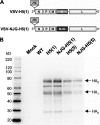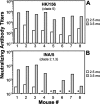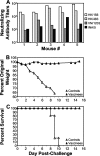Potent vesicular stomatitis virus-based avian influenza vaccines provide long-term sterilizing immunity against heterologous challenge
- PMID: 20181720
- PMCID: PMC2863739
- DOI: 10.1128/JVI.02637-09
Potent vesicular stomatitis virus-based avian influenza vaccines provide long-term sterilizing immunity against heterologous challenge
Abstract
The emergence in 1997 and continuance today of a highly lethal H5N1 avian influenza virus (AIV) causing human disease has raised concern about an impending pandemic and the need for a vaccine to prepare for such an occurrence. We previously generated an efficacious vesicular stomatitis virus (VSV)-based AIV vaccine expressing H5 hemagglutinin (HA) from the fifth genomic position of VSV (J. A. Schwartz et al., Virology 366:166-173, 2007). Here we have generated and characterized VSV-based vaccines that express the A/Hong Kong/156/1997 (clade 0) H5 HA from the first position of the VSV genome. These vectors induce broadly cross-neutralizing antibodies against homologous and heterologous H5N1 viruses of different clades in mice. The vaccines provide complete protection against morbidity and mortality after heterologous challenge with clade 0 and clade 1 strains in animals even 1 year after vaccination. Postchallenge pulmonary virus loads show that these vectors provide sterilizing immunity. Therefore, VSV-based AIV vaccines are potent, broadly cross-protective pandemic vaccine candidates.
Figures





Similar articles
-
A viable recombinant rhabdovirus lacking its glycoprotein gene and expressing influenza virus hemagglutinin and neuraminidase is a potent influenza vaccine.J Virol. 2015 Mar;89(5):2820-30. doi: 10.1128/JVI.03246-14. Epub 2014 Dec 24. J Virol. 2015. PMID: 25540378 Free PMC article.
-
Vesicular stomatitis virus-based H5N1 avian influenza vaccines induce potent cross-clade neutralizing antibodies in rhesus macaques.J Virol. 2011 May;85(9):4602-5. doi: 10.1128/JVI.02491-10. Epub 2011 Feb 16. J Virol. 2011. PMID: 21325423 Free PMC article.
-
Vaccination with Vesicular Stomatitis Virus-Vectored Chimeric Hemagglutinins Protects Mice against Divergent Influenza Virus Challenge Strains.J Virol. 2015 Dec 16;90(5):2544-50. doi: 10.1128/JVI.02598-15. J Virol. 2015. PMID: 26676789 Free PMC article.
-
Recombinant parainfluenza virus 5 vaccine encoding the influenza virus hemagglutinin protects against H5N1 highly pathogenic avian influenza virus infection following intranasal or intramuscular vaccination of BALB/c mice.J Virol. 2013 Jan;87(1):363-71. doi: 10.1128/JVI.02330-12. Epub 2012 Oct 17. J Virol. 2013. PMID: 23077318 Free PMC article.
-
Recombinant vectors as influenza vaccines.Curr Top Microbiol Immunol. 2009;333:243-67. doi: 10.1007/978-3-540-92165-3_13. Curr Top Microbiol Immunol. 2009. PMID: 19768410 Free PMC article. Review.
Cited by
-
A viable recombinant rhabdovirus lacking its glycoprotein gene and expressing influenza virus hemagglutinin and neuraminidase is a potent influenza vaccine.J Virol. 2015 Mar;89(5):2820-30. doi: 10.1128/JVI.03246-14. Epub 2014 Dec 24. J Virol. 2015. PMID: 25540378 Free PMC article.
-
Immunobiology of influenza vaccines.Chest. 2013 Feb 1;143(2):502-510. doi: 10.1378/chest.12-1711. Chest. 2013. PMID: 23381315 Free PMC article. Review.
-
Experimental vaccines against potentially pandemic and highly pathogenic avian influenza viruses.Future Virol. 2013 Jan 1;8(1):25-41. doi: 10.2217/fvl.12.122. Future Virol. 2013. PMID: 23440999 Free PMC article.
-
Vesicular stomatitis virus-based H5N1 avian influenza vaccines induce potent cross-clade neutralizing antibodies in rhesus macaques.J Virol. 2011 May;85(9):4602-5. doi: 10.1128/JVI.02491-10. Epub 2011 Feb 16. J Virol. 2011. PMID: 21325423 Free PMC article.
-
Vaccination with Vesicular Stomatitis Virus-Vectored Chimeric Hemagglutinins Protects Mice against Divergent Influenza Virus Challenge Strains.J Virol. 2015 Dec 16;90(5):2544-50. doi: 10.1128/JVI.02598-15. J Virol. 2015. PMID: 26676789 Free PMC article.
References
-
- Banzhoff, A., R. Gasparini, F. Laghi-Pasini, T. Staniscia, P. Durando, E. Montomoli, P. L. Capecchi, P. di Giovanni, L. Sticchi, C. Gentile, A. Hilbert, V. Brauer, S. Tilman, and A. Podda. 2009. MF59-adjuvanted H5N1 vaccine induces immunologic memory and heterotypic antibody responses in non-elderly and elderly adults. PLoS One 4:e4384. - PMC - PubMed
-
- Carter, N. J., and G. L. Plosker. 2008. Prepandemic influenza vaccine H5N1 (split virion, inactivated, adjuvanted) [Prepandrix]: a review of its use as an active immunization against influenza A subtype H5N1 virus. BioDrugs 22:279-292. - PubMed
-
- Chen, H., G. J. Smith, K. S. Li, J. Wang, X. H. Fan, J. M. Rayner, D. Vijaykrishna, J. X. Zhang, L. J. Zhang, C. T. Guo, C. L. Cheung, K. M. Xu, L. Duan, K. Huang, K. Qin, Y. H. Leung, W. L. Wu, H. R. Lu, Y. Chen, N. S. Xia, T. S. Naipospos, K. Y. Yuen, S. S. Hassan, S. Bahri, T. D. Nguyen, R. G. Webster, J. S. Peiris, and Y. Guan. 2006. Establishment of multiple sublineages of H5N1 influenza virus in Asia: implications for pandemic control. Proc. Natl. Acad. Sci. U. S. A. 103:2845-2850. - PMC - PubMed
Publication types
MeSH terms
Substances
Grants and funding
LinkOut - more resources
Full Text Sources
Other Literature Sources
Medical

